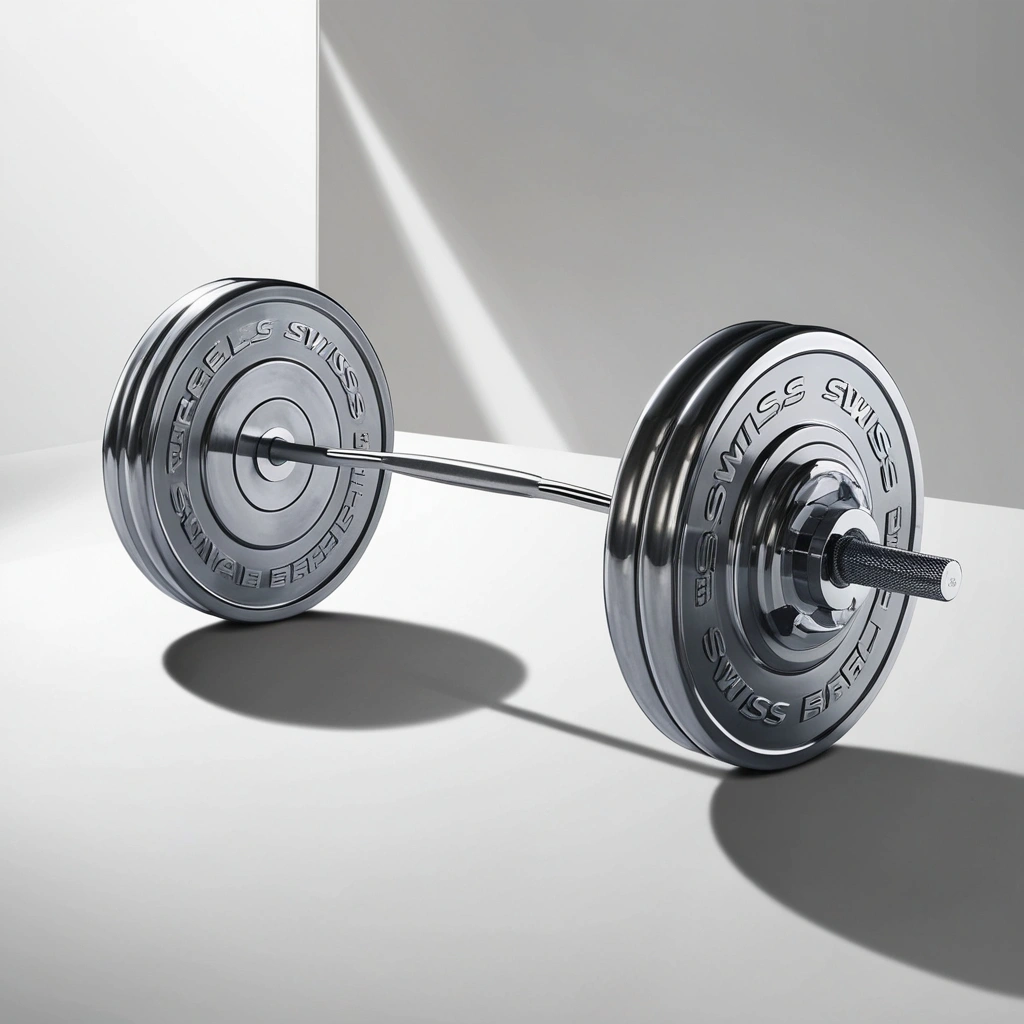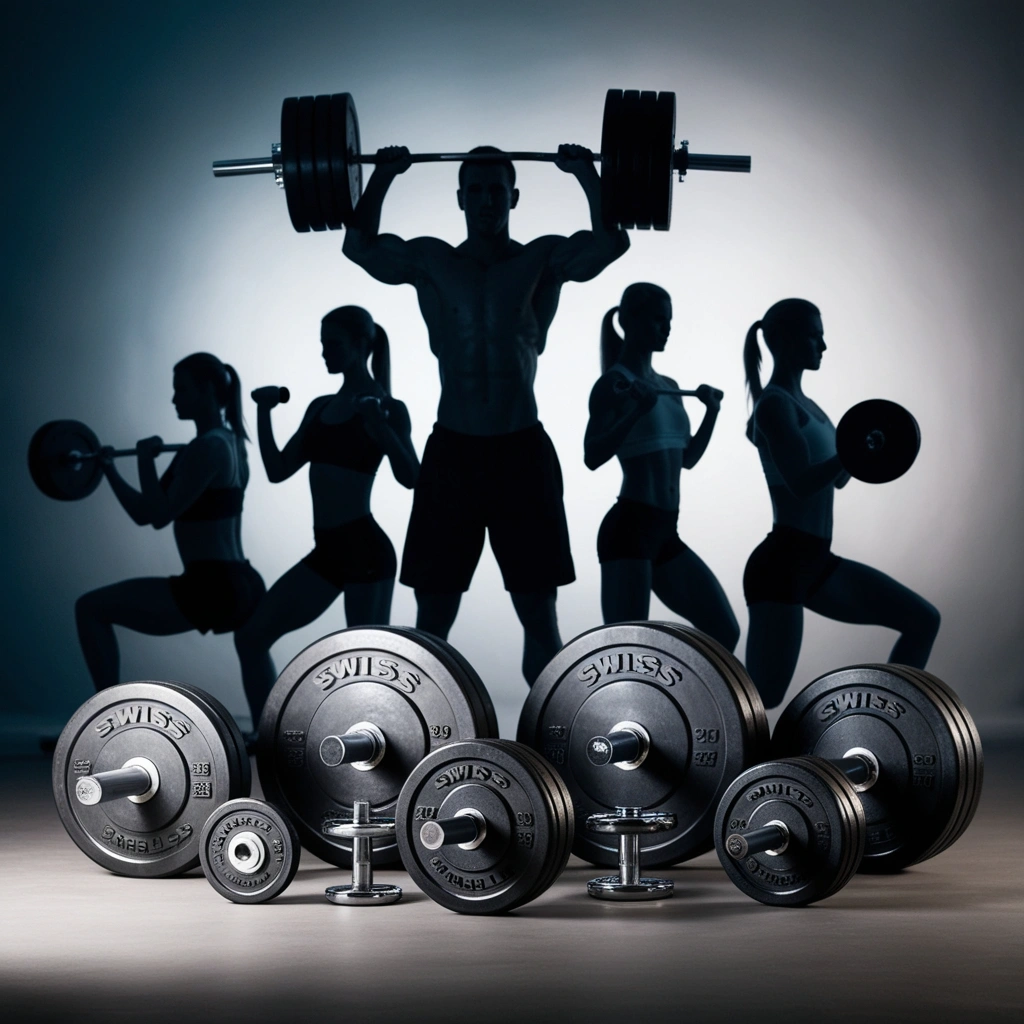The Swiss barbell is also known as the football bar or multi-grip barbell. It has grown popular in recent years. This is because of its unique design and versatility for strength training.
It comes from the world of powerlifting and strength sports. This barbell has many grip options. They target different muscles and reduce strain on the joints. This is a full guide. We’ll explore the Swiss barbell in detail.
We’ll cover its anatomy, advantages, Popular Exercises, and maintenance tips. Are you a seasoned lifter looking to add variety to your workouts? Or are you a beginner seeking an effective and safe way to build strength? The Swiss barbell is a valuable addition to any fitness routine.
Join us as we explore the Swiss Barbell. We will uncover its benefits, how to use it, and factors for adding it to your training. Discover how this new equipment can boost your strength. It can also improve your muscles and help on your fitness journey.
Anatomy of a Swiss Barbell
The Swiss barbell has a unique design. It sets it apart from straight barbells. Let’s explore its key features:
Unique Design Features
- The Swiss barbell has a hexagonal or rectangular frame. It has many sets of parallel handles welded at different angles. This design allows for a variety of grip positions, ranging from neutral to angled grips.
- Unlike straight barbells, the Swiss barbell’s handles are closer together. This promotes a more ergonomic and comfy grip for users of all sizes.
- Some Swiss barbells may have extra features. These include angled ends or knurled handles. They improve grip and stability during lifts.
Variations in Grip Angles
- A defining trait of the Swiss barbell is its versatility. It can be gripped at many angles. The models offer a range of grip options. These include neutral, pronated, supinated, and angled grips.
- Each grip angle targets Secret Muscles. They also offer varying shoulder, elbow, and wrist comfort. This versatility allows for greater customization and specificity in training routines.
- The different grip angles make the Swiss barbell ideal for individual preferences. It also helps with muscle imbalances. And, it provides options for people with joint or mobility issues.
Material and Construction
- Swiss barbells are often made from high-quality steel or aluminum. This ensures they are durable and stable during lifts. The choice of materials may vary depending on the manufacturer and intended use.
- The Swiss barbell handles may have knurling or textures. These improve grip and prevent slippage during lifts. Some models may also include rotating sleeves or bushings. These make movement smoother and reduce friction.
- The Swiss barbell is built to hold heavy loads and withstand lots of use. This makes it good for both gyms and home workouts.
You must understand the Swiss barbell’s anatomy. This is key to getting its benefits and using it well in your training. The Swiss barbell has unique design features.
It has versatile grip angles and durable construction. The barbell is a versatile and useful tool. It is for building strength, muscle mass, and fitness.

Advantages of Using a Swiss Barbell
The Swiss barbell has many advantages. They make it a valuable addition to any strength training regimen. Let’s explore these benefits:
Reduced Strain on Joints
- The Swiss barbell has an ergonomic design. It promotes a more natural and comfortable grip than traditional straight barbells.
- The Swiss barbell has many grip options. They let users find a position. This position reduces stress on the wrists, elbows, and shoulders during lifts.
- The Swiss barbell reduces strain on the joints. This helps prevent overuse injuries and discomfort. So, it is good for people with pre-existing joint issues or mobility limits.
Versatility for Different Exercises
- The Swiss barbell has a unique design. It offers versatility for a wide range of exercises. These include pressing, pulling, and rowing.
- The Swiss barbell has many grip angles and handle positions. You can use it for exercises. These include bench presses, rows, shoulder presses, curls, and triceps extensions.
- Switching grip positions lets muscles engage more. This leads to better strength and fitness.
Targeting Specific Muscle Groups
- The Swiss barbell also has another advantage. It can target muscles better than traditional barbells.
- By adjusting the grip angle and hand position, users can target different muscles. For example, they can target the chest, shoulders, back, or arms.
- This targeted approach helps users fix muscle imbalances, weak points, or lagging areas. It leads to more balanced and symmetrical muscle growth.
Choosing the Right Swiss Barbell
Choosing the right Swiss barbell involves considering many key factors. They ensure it meets your needs and preferences. Here’s what to consider:
Grip Width Options
- Swiss barbells come in various grip widths. They fit different body types and lifting styles. Consider the handle width and the space between them. Use these to find a barbell that feels safe and comfy in your hands.
- Some Swiss barbells offer adjustable grip widths. They let users set the spacing between handles to fit their needs. This flexibility is particularly beneficial for users with broader or narrower shoulders.
Material Considerations
- When choosing a Swiss barbell, pay attention to the material used in its construction. The bars are made of high-quality steel or aluminum alloy. They are durable and stable during lifts. This ensures long-term performance and safety.
- Consider extra features. These include knurled handles or textured surfaces. They improve grip and stop slippage during exercises. Look for a barbell with a comfortable and secure grip to enhance your lifting experience.
Weight Capacity and Durability
- Check the weight capacity and durability of the Swiss barbell. It should meet your strength goals and hold heavy loads for a long time.
- Check the barbell’s max weight rating. Also, check the quality of the frame and handles. Look for strong welds. Also, look for tough sleeves and finishes. They can handle heavy lifting and frequent use.
- Consider factors such as the barbell’s intended use (e.g., home gym vs. commercial gym). Also, consider the types of exercises you plan to do with it. Choose a Swiss barbell that matches your training intensity and long-term fitness goals.

Popular Exercises with the Swiss Barbell
The Swiss barbell is very versatile. It is a valuable tool. It can be used for a wide range of exercises. Here are some popular exercises that can be done with the Swiss barbell:
Bench Press Variations
- The neutral-grip bench press is performed with a Swiss barbell. It targets the chest, shoulders, and triceps. It also reduces strain on the shoulders and wrists.
- You can adjust the bench angle for the Incline and Decline Bench Press. This targets different areas of the chest and shoulders.
Rows and Pulling Movements
- Bent-Over Rows: Hold the Swiss barbell with a pronated or neutral grip. Do bent-over rows to target the upper back, lats, and biceps.
- Lat Pulldowns: Attach the Swiss barbell to a cable machine. Do lat pulldowns to target the latissimus dorsi muscles. This improves back strength and stability.
Shoulder and Arm Exercises
- Do overhead presses with the Swiss barbell. They target the shoulders, triceps, and upper chest. The neutral grip position reduces strain on the shoulders and wrists. It’s better than traditional barbells.
- Do bicep curls with the Swiss barbell. Alternate your grip to target the biceps from many angles.
- Do tricep extensions with the Swiss barbell. Use different grip angles to target the triceps well.
Adding these exercises to your workout with the Swiss barbell helps improve strength. They also build muscle and fitness. The Swiss barbell is very versatile. It allows for endless exercise variations. This makes it a valuable addition to any strength training program.
Incorporating the Swiss Barbell into Your Workout Routine
You can add the Swiss barbell to your workout routine. It can help you meet specific fitness goals. Here’s how to incorporate it effectively:
Warm-up and Activation Exercises
- Use the Swiss barbell for warm-up exercises. They prepare your muscles and joints for harder lifting. Do light sets of exercises. Use the Swiss barbell. Do shoulder presses, rows, and curls. They will boost blood flow and motion.
- Use activation exercises for specific muscles. For example, do rotator cuff exercises or scapular retractions. Use the Swiss barbell. These exercises help wake up the muscles. They do this before heavier lifting. This cuts the risk of injury and boosts performance.
Strength and Hypertrophy Training
- Use the Swiss barbell for classic strength and hypertrophy training. You can use it for bench presses, rows, and overhead presses. Experiment with different grip positions and angles to target various muscle groups effectively.
- Use the Swiss barbell to add compound and isolation exercises to your routine. They challenge different muscle groups and spur muscle growth. Focus on progressive overload. You do it by slowly increasing weight and volume over time. This is how you keep making strength and size gains.
Rehabilitation and Injury Prevention
- The Swiss barbell has a neutral grip. Its design is ergonomic. It is good for people recovering from upper body injuries. It is also good for people dealing with joint issues. Use light resistance exercises with the Swiss barbell. They help rehab and strengthen the affected muscles. They do so without making pain or discomfort worse.
- Use the Swiss barbell for corrective exercises. They target muscle imbalances or weaknesses that raise injury risk. Do exercises like face pulls, external rotations, and reverse flies. They improve posture, shoulder stability, and joint health.
- Include prehabilitation exercises with the Swiss barbell in your routine. They prevent injuries before they occur. Focus on strengthening and stabilizing muscles. Also, aims to improve mobility and enhance neuromuscular control. This will reduce the likelihood of overuse injuries and boost athletic performance.

Maintenance and Care of Swiss Barbells
You must maintain and care for your Swiss barbell. This is essential for keeping its performance, longevity, and safety. Here’s how to keep your Swiss barbell in top condition:
Cleaning and Disinfecting
- After each use, wipe the Swiss barbell with a clean, damp cloth. Use water and mild soap to remove sweat, oils, and debris. Pay particular attention to the grip areas and any textured surfaces.
- Disinfect the Swiss barbell often. This kills bacteria and stops the spread of germs. Use a disinfectant spray or solution for fitness equipment. Use one recommended by the manufacturer and follow their instructions carefully.
- Let the Swiss barbell air dry. Do this before storing it. It prevents moisture buildup and corrosion. Avoid harsh chemicals. Also, avoid abrasive cleaners. They may damage the barbell’s finish or coating.
oper Storage Techniques
- Store the Swiss barbell in a clean, dry place. Keep it away from moisture, humidity, and very hot or cold temperatures. Avoid leaving the barbell in direct sunlight. It can fade or warp the materials.
- Use a designated storage rack or stand to keep the Swiss barbell organized and off the floor. Make sure the storage area has good airflow. Also, keep it free from dust and debris. They can build up on the barbell’s surface.
- Store the Swiss barbell upright. Keep the handles facing up. This prevents the frame from bending. Don’t lean the barbell against walls or other equipment. This can lead to damage or instability.
Inspection and Maintenance Tips
- Regularly inspect the Swiss barbell for signs of wear, damage, or loose components. Check the welds, sleeves, and handles for cracks, dents, or corrosion. These issues could harm the barbell.
- Tighten any loose bolts or fasteners and replace any worn or damaged parts as needed. Grease the sleeves and rotating parts often. This keeps them moving smoothly and cuts friction.
- If the Swiss barbell rusts, sand the rusty areas with fine sandpaper. Then, apply rust-resistant primer and paint to protect the surface. Allow the paint to dry completely before using the barbell again.
Where to Find Swiss Barbells
Swiss barbells are widely available from various retailers and online platforms. Here are some options for purchasing:
Local Fitness Equipment Retailers
- Visit local fitness equipment retailers. Also, try specialty sports stores or gym supply shops in your area. They often sell Swiss barbells. They also carry other strength gear and accessories.
- Check with commercial gyms or fitness centers. They may sell Swiss barbells to their members or clients. You can ask about buying options. Or, you can place a special order there.
Online Fitness Stores and E-commerce Platforms
- Explore online fitness stores. Also, check e-commerce platforms and marketplaces that specialize in selling exercise equipment. Websites such as Amazon, Rogue Fitness, or Titan Fitness sell Swiss barbells. They come in many styles, sizes, and prices.
- Browse customer reviews, ratings, and product descriptions. Use them to compare Swiss barbell models. Find the one that best suits your needs and preferences. Look for retailers that offer reliable shipping. Also, look for ones with good return policies and customer support. These things ensure a good shopping experience.
Considerations for Purchasing
- Before buying, consider factors. These include the size, weight limit, and grip options of the Swiss barbell. This will ensure it meets your training needs.
- Set your budget. Then, compare prices at different retailers to find the best value. Consider any extra costs, like shipping fees and taxes. Also, consider assembly services. Keep these in mind when budgeting for your purchase.
- Read customer reviews and testimonials. They will show you the quality, durability, and performance of the Swiss barbell. They are from real users. Look for feedback on factors. These include construction, grip comfort, and overall satisfaction with the product.
- Check the warranty and return policy. They are offered by the retailer or manufacturer. They are to ensure peace of mind with your purchase. Look for a good warranty and flexible returns. This is in case the Swiss barbell doesn’t meet your expectations.
Conclusion
The Swiss barbell is a versatile and effective tool for strength training. It offers many benefits and uses for fitness fans of all levels. The Swiss barbell has a unique design. It offers ergonomic grip options and can be used for many exercises.
It has become popular for people looking to boost their strength, muscle mass, and fitness. In this guide, we’ve explored the Swiss barbell’s anatomy and its advantages. We also covered popular exercises and tips for buying and maintaining it. It reduces strain on joints. It targets muscles and aids in rehab.
The Swiss barbell has many benefits. They make it a valuable addition to any workout routine. You can use the Swiss barbell for bench presses, rows, and shoulder presses. It’s also great for rehab exercises.
The Swiss barbell is safe, effective, and fun. It’s a great way to achieve your fitness goals. Use the Swiss barbell in your workouts. Follow its maintenance and care guidelines. Doing this will maximize its benefits and ensure it lasts.
Discover the power of the Swiss barbell. It will unlock new levels of strength. It will also bring stability and muscle growth to your fitness journey. You can train at home, in a gym, or on the go. The Swiss barbell offers many ways to boost your strength training. It can help you reach your fitness goals.

